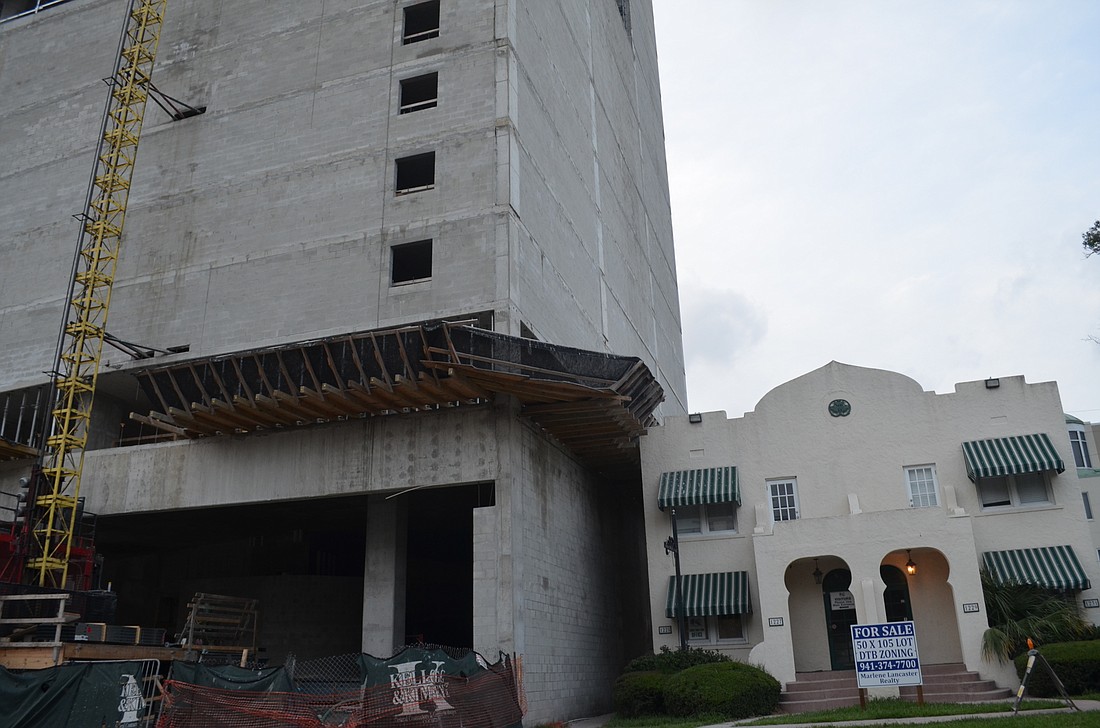- April 25, 2024
-
-
Loading

Loading

During construction of the 18-story, 180-room Embassy Suites hotel at 202 N. Tamiami Trail, Alex Lancaster has grown increasingly concerned about something looming over him.
That’s not a figurative statement. Lancaster is a trustee of the group that owns the two-story building at 1225 Second St., right next to the Embassy Suites construction site. The new high-rise towers over the office building, separated by just a few feet. Space is so tight, some scaffolding from the hotel extends over the roof of the neighboring structure.
That scaffolding is one of Lancaster’s primary issues with the project. In December, he filed a lawsuit against contractor Kellogg and Kimsey and developer Jebco Ventures. He alleged the project was intruding on his property. Originally, the complaint alleges, the construction team installed scaffolding on the ground on his property, which Lancaster had not approved.
Although the builder replaced it with scaffolding about 30 feet above the ground, Lancaster said that it still violates the air rights above his property. He believes the construction makes a segment of his property a “hard hat area,” impeding his ability to do business.
On May 12, representatives for the defendants filed a response contesting Lancaster’s allegations, asking a judge to dismiss the lawsuit. The response states that the scaffolding is temporary and is designed to protect the neighboring property. Additionally, the owner of the hotel property is leasing the offices underneath the scaffolding.
The defendants contend the scaffolding doesn’t represent an unlawful use of someone else’s property. And though Lancaster is seeking an injunction blocking the use of the space above his building, they say removing the scaffolding would only create a more dangerous situation.
“The temporary scaffolding actually protects individuals who access the western side of the building on the property and any property in the area from potential falling objects due to construction,” the response states.
The legal dispute is yet another downtown development controversy regarding projects being built out to the underlying property’s boundaries.
During the past two years, residents and businesses have complained about debris falling off construction sites onto neighboring properties. Many of these complaints have blamed zero-lot-line construction, arguing it’s too tight a space to build a structure without infringing on the project’s surroundings.
The city has largely stayed out of these types of disputes between neighboring property owners. Although city building official Larry Murphy has intervened to make sure construction crews are following the proper regulations, City Attorney Robert Fournier said many of these disagreements are civil issues that the city doesn’t oversee.
Fournier said he hasn’t looked into whether other cities have more specific regulations managing construction in a dense, urban area. He suggested it might be a problem the private property owners could sort out themselves.
“If they both can build to the lot line, it seems mutually beneficial for them to come to some agreement,” Fournier said.
Construction companies say it’s possible to build in a tight urban setting without causing issues for adjacent property owners. Still, they add that construction inherently comes with risks, and cooperation with neighbors can help a project proceed more smoothly and swiftly.
Tracy Dawson, Kellogg and Kimsey marketing manager, commented generally on the company’s procedures when building zero-lot-line projects. She said every construction site will have falling debris. The contractor’s job is to make sure any construction issues are contained to the work site.
“We have protective coverings up to protect things from blowing off the building,” Dawson said. “We have a debris catch net so it doesn’t get caught on the road. That’s part of our construction plans across the board.”
Although a recent uptick in construction may have highlighted these issues, Core Construction President John Wiseman said building in these conditions isn’t new for downtown Sarasota. He recalled working on the parking garage on Mira Mar Court in 1983, which is also built out to the property line.
He listed many of the same precautionary measures Dawson discussed — anchoring anything hanging off the building, making sure cranes don’t swing any materials over the top of other buildings, installing netting to catch any debris that does fall.
“Any time you’re around an area of construction, you should be concerned.” — John Wiseman
That’s not to say residents’ fears are necessarily misplaced regarding adjacent construction.
“Any time you’re around an area of construction, you should be concerned,” Wiseman said. “It’s no different than walking on a busy street — you have a different level of awareness than walking in your backyard.”
Both Wiseman and Dawson said their companies try to work with neighboring property owners to make them aware of the construction schedule and work out any mutually beneficial arrangements. Wiseman said developers and builders want a project to be completed as quickly as possible, too, so there are some shared interests between the two groups.
If anyone is holding out for a construction project next door that’s free of issues, Wiseman said they shouldn’t get their hopes up. But, contrasted with a city in which there is no activity in the downtown core, he argued this is a good problem to have.
“It is an inconvenience,” Wiseman said. “But that’s part of living in an urban environment where you see growth and prosperity and people wanting to improve their properties.”